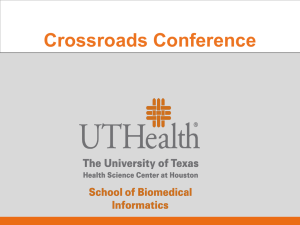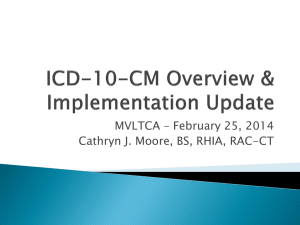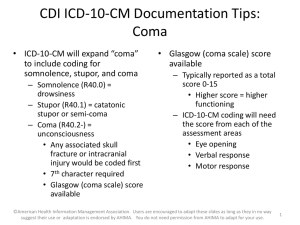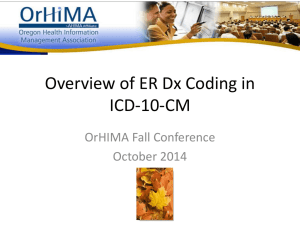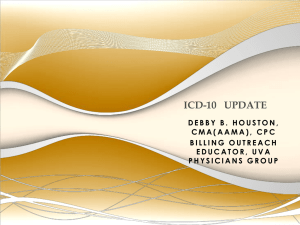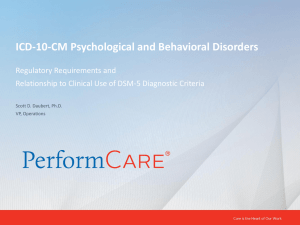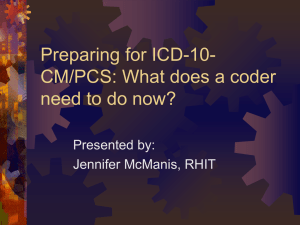Click Below to
advertisement
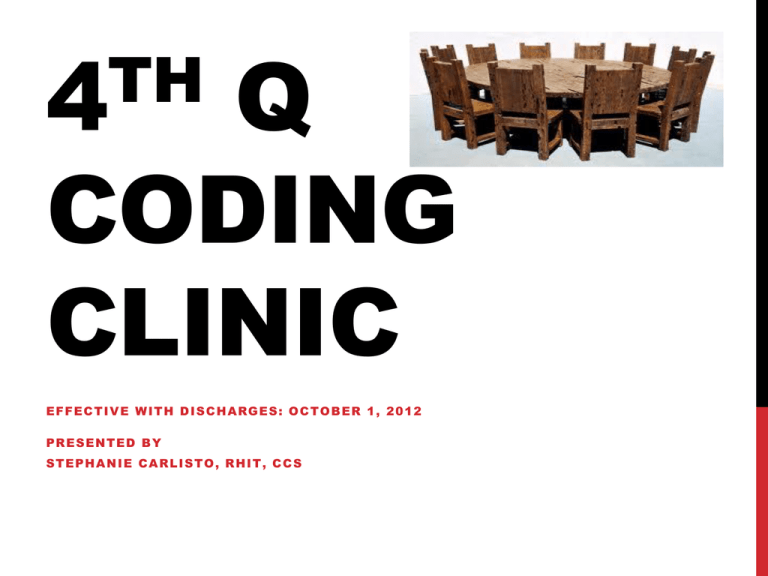
TH 4 Q CODING CLINIC E F F E C T I V E W I T H D I S C H A RG E S : O C T O B E R 1 , 2 0 1 2 PRESENTED BY STEPHANIE CARLISTO, RHIT, CCS CODE SET FREEZE There is a partial code set freeze in preparation for ICD-10-CM/PCS implementation, there are no new or revised ICD-9-CM diagnosis codes, or ICD-9-CM changes to the Official Guidelines for Coding and Reporting for Fiscal Year 2013. CMS announced on September 15, 2010, that a partial freeze of both ICD-9-CM and ICD-10CM/PCS codes (ICD-10 code sets) would be implemented as follows: The last regular annual update to both ICD-9-CM and ICD-10 code sets was made on October 1, 2011. On October 1, 2012, there will be only limited code updates to both ICD- 9-CM and ICD-10 code sets to capture new technology and new diseases. On October 1, 2013, there were to be only limited code updates to ICD-10 code sets to capture new technology and new diseases. There were to be no updates to ICD-9-CM on October 1, 2013, as the system would no longer be a HIPAA standard and, therefore, no longer be used for reporting. With the proposed ICD-10 implementation delay, there will be only limited code updates to both ICD-9-CM and ICD-10 to capture new technology and new diagnoses on October 1, 2013. Regular updates to ICD-10-CM and ICD-10-PCS will begin one year after the implementation of ICD-10. October 1, 2015. CRESCENDO ANGINA PRINCIPAL PROCEDURE A patient had a percutaneous transluminal coronary angioplasty (PTCA) with administration of thrombolytic agent in an effort to prevent an impending myocardial infarction after presenting with severe crescendo angina. What should be the principal procedure? Assign code 00.66, percutaneous transluminal coronary angioplasty [PTCA], as the principal procedure. Assign code 99.10, Injection or infusion of thrombolytic agent, as a secondary procedure. DECOMPENSATED CHF W/ PLEURAL EFFUSION PRINCIPAL PROCEDURE A patient is admitted for decompensated congestive heart failure (CHF) with pleural effusion. The patient also has type 2 diabetes mellitus with peripheral vascular disease with a chronic foot ulcer. Due to the pleural effusion patient has a thoracentesis to drain fluid. During the course of the hospital stay, the patient’s diabetic foot ulcer worsens and must be surgically debrided down to muscle and bone. How would you sequence the procedures performed on this encounter? 34.91, Thoracentesis, as the principal procedure, since it is the procedure is associated with the principal diagnosis. 77.68, Local excision of lesion or tissue of bone, tarsals and metatarsals, as a secondary procedure, since it was performed for a condition that developed after admission. PRINCIPAL PROCEDURE FOR MALIGNANT NEOPLASM OF OVARY A patient with a malignant neoplasm of the ovary is admitted for surgery. A bilateral salpingo-oophorectomy and hysterectomy are performed. Which procedure code should be listed as the principal procedure on the record, 65.61, Other removal of both ovaries and tubes at same operative episode, or 68.49, Total abdominal hysterectomy? Assign code 65.61, Other removal of both ovaries and tubes at same operative episode, as the principal procedure, since it is the procedure most closely related to the principal diagnosis. Assign code 68.49, Total abdominal hysterectomy, as a secondary procedure. CEREBRAL NEOPLASM PRINCIPAL PROCEDURE A patient with a cerebral neoplasm is admitted for surgery. An open biopsy of the brain is performed and the neoplasm is found to be an inoperable and malignant. During the procedure, an artery is accidentally lacerated and is sutured to control the bleeding. Which procedure code should be listed as the principal procedure on the record, 01.14, Open biopsy of brain or 39.31, Suture of artery? 01.14, Open biopsy of brain, as the principal procedure. Even though the biopsy is a diagnostic procedure, rather than a treatment, it is the procedure that is related to the principal diagnosis. 39.31, Suture of artery, as a secondary procedure, since it was performed for the complication during surgery. PACEMAKER LEAD DISPLACEMENT PRINCIPAL PROCEDURE A patient with displacement of a cardiac pacemaker lead is admitted for revision of the lead. The patient also has internal hemorrhoids. The pacemaker lead is repositioned. During the recovery period, the patient has significant rectal bleeding from the internal hemorrhoids. A hemorrhoid ligation is performed to control the bleeding. Which procedure code should be listed as the principal procedure on the record, 37.75, Revision of lead, or 49.45, hemorrhoid ligation? 37.75, Revision of lead, as the principal procedure, since it was the procedure most closely related to the principal diagnosis 49.45, Hemorrhoid ligation as a secondary procedure. INJECTION OR INFUSION OF GLUCARPIDASE Effective October 1, 2012, a new procedure code (00.95) was created to describe the administration of glucarpidase (Voraxaze®) used to treat cancer patients with toxic levels of methotrexate in their blood due to renal impairment which prevents clearance of the drug from their systems. Prior to this, the injection or infusion of glucarpidase was coded to 99.29, Injection or infusion of other therapeutic or prophylactic substance Methotrexate is one of the most commonly used anti-cancer agents. The administration of high dose methotrexate is an important component in the treatment of a variety of cancers. Voraxaze® is not indicated for use in patients who display the expected outcome of methotrexate or those with normal or mildly impaired renal function because of the potential risk of subtherapeutic exposure to methotrexate. (Meaning if your renal function is adequate, the Methotrexate levels may not be high enough to be effective to treat the cancer.) New code 00.95 Injection or infusion of glucarpidase PLACEMENT OF SUBCUTANEOUS IMPLANTABLE CARDIOVERTER DEFIBRILLATOR What are the correct code assignments for implantation, replacement, or revision of a totally subcutaneous implantable defibrillator system? Use the existing defibrillator codes as follows, as ICD-9-CM does not distinguish the location of cardioverter/defibrillator implantations: Implantation: 37.94, Implantation or replacement of automatic cardioverter/defibrillator, total system [AICD] 37.95, Implantation of automatic cardioverter defibrillator lead(s) only 37.96, Implantation of automatic cardioverter/ defibrillator pulse generator only Replacement: 37.97, Replacement of automatic cardioverter defibrillator lead, only 37.98, Replacement of automatic cardioverter/ defibrillator pulse generator only Revision: 37.79, Revision or relocation of cardiac device pocket 37.75, Revision of lead [electrode] DIAGNOSTIC PROCEDURE OR DEFINITIVE TREATMENT AS PRINCIPAL PROCEDURE A patient is admitted for biopsy of a cerebral neoplasm. During the encounter, the patient has significant rectal bleeding due to internal hemorrhoids. A hemorrhoid ligation is performed to control the bleeding. Which procedure code should be listed as the principal procedure, 01.14, Open biopsy of brain, or 49.45, hemorrhoid ligation? Assign code 01.14, Open biopsy of brain, as the principal procedure. Code 49.45, hemorrhoid ligation should be added as a secondary procedure. Although the biopsy is a diagnostic procedure, rather than definitive treatment, it is sequenced as the principal procedure, since it’s the procedure most closely related to the principal diagnosis. LUMBAR VERTEBRAE FRACTURE W/ ASPIRATION PNEUMONIA AND ARDS PRINCIPAL PROCEDURE A patient with compression fracture of the first lumbar vertebrae is admitted. Percutaneous vertebroplasty using methylmethacrylate is performed. Several days after the procedure, the patient is diagnosed with aspiration pneumonia with acute respiratory failure. The patient cannot be intubated due to severe edema of the airway so a tracheostomy is done. The patient is on mechanical ventilation for 48 hours, and is eventually discharged after the pneumonia is resolved and the tracheostomy removed. Which procedure code should be listed as the principal procedure on the record, 81.65, Percutaneous vertebroplasty, or 31.29, Other permanent tracheostomy? 81.65, Percutaneous vertebroplasty, as the principal procedure, since it is the procedure most closely related to the principal diagnosis. 31.29, Other permanent tracheostomy, as a secondary procedure, since it was performed for a condition that developed after admission. ESOPHAGEAL VARICES PRINCIPAL PROCEDURE A patient with alcoholic liver disease and portal hypertension is admitted with bleeding esophageal varices. The patient undergoes esophagogastroduodenoscopy (EGD) with an attempted banding of the varices. The banding procedure is discontinued due to patient becoming agitated, the varices stop oozing during the hospital stay with medical management. The patient then developed chest pain with an elevation of troponin. The patient also has a history coronary artery disease and coronary bypass surgery. During this admission, a 90% blockage is discovered in the native obtuse marginal artery, and percutaneous transluminal coronary angioplasty (PTCA) is successfully performed. Which procedure code should be listed as the principal procedure on the record, 45.13, Other endoscopy of small intestine, or 00.66, Percutaneous transluminal coronary angioplasty [PTCA]? Assign code 45.13, Other endoscopy of small intestine, as the principal procedure, since it is the procedure most closely related to the principal diagnosis, even though the procedure was discontinued. Assign code 00.66, Percutaneous transluminal coronary angioplasty [PTCA] as a secondary diagnosis. ESOPHAGEAL VARICES PRINCIPAL PROCEDURE A patient with hepatic encephalopathy and alcoholic cirrhosis is admitted. During the encounter, the patient had hemoptysis and underwent an esophagogastroduodenoscopy (EGD) for suspected esophageal varices, they were confirmed to be present, but not bleeding. However, a few days later, the varices ruptured and the patient required endoscopic banding of the esophageal varices. What should be the principal procedure? Assign code 42.33, Endoscopic excision or destruction of lesion or tissue of esophagus, for the endoscopic banding of esophageal varices, as the principal procedure. There were no procedures performed related to the principal diagnosis and the banding of the esophageal varices was the procedure performed for definitive treatment of the secondary diagnosis. Assign code 45.13, Other endoscopy of small intestine, as a secondary procedure. CODING CLINIC FOR ICD10-CM INTRODUCTION From CC 4th 1. 2014, “Although ICD-10-CM and ICD-10-PCS have not been implemented yet, in response to requests from the coding community, the AHA Central Office announced last November that interested parties may start sending ICD-10- CM/PCS questions to the AHA Central Office. However, just as with ICD- 9-CM, inquirers must have a working knowledge of ICD-10-CM and ICD- 10-PCS coding when submitting a question. The service is limited to providing coding advice and not advice on the General Equivalence Mappings (GEMs) or implementation issues. Please refer to the AHA’s website for information on submission of requests for coding advice: www.ahacentraloffice.org” “The following ICD-10-CM and ICD-10-PCS coding questions have been reviewed and approved through the same process used for all Coding Clinic issues. Future issues of Coding Clinic will continue to include ICD-10-CM/ PCS issues as approved by the Editorial Advisory Board.” ACUTE EXACERBATION OF ASTHMA AND STATUS ASTHMATICUS The question posed to CC was as follows: “Are we to assume that ICD-9-CM guidelines not included in ICD-10-CM will not be valid beginning when ICD-10-CM is implemented? For example, ICD-9CM guideline Section I.C8.a.4, "Acute exacerbation of asthma and status asthmaticus" does not have a counterpart in the ICD-10-CM guidelines.” Their response was: “Every effort was made to carry over the ICD-9-CM guidelines and concepts into ICD-10-CM, unless there was a specific change in ICD-10-CM that precluded the incorporation of the same concept into ICD-10-CM. However, some of the guidelines in ICD-9-CM included information that may have been clinical in nature (as in the example noted in the question) and therefore not appropriate for coding guidelines.” As far as coding of acute exacerbation of asthma and status asthmaticus together in ICD-10-CM, CC’s advice is “only the code for the more severe condition (i.e., status asthmaticus) should be assigned.” ACUTE EXACERBATION OF ASTHMA AND STATUS ASTHMATICUS Asthma, asthmatic (bronchial) (catarrh) (spasmodic) J45.909 - With - exacerbation (acute) J45.901 - - - - status asthmaticus J45.902 CROHN’S DISEASE WITH RECTAL ABSCESS The following ICD-10-CM codes K50.014, K50.114, K50.814 and K50.914 are used to identify Crohn’s disease with intestinal abscess. If a patient presents with Crohn’s disease of the small intestine with a rectal abscess, should we assign an additional code for the rectal abscess? It is appropriate to assign code K50.014, Crohn’s disease of small intestine with abscess, along with code K61.1, Rectal abscess, the additional code provides more information regarding the site of the abscess. Codes in category K50 describe intestinal abscess only. INITIAL ENCOUNTER FOR FRACTURE MALUNION A patient fell and sustained a fracture of his left wrist but did not seek medical treatment for some time. He now seeks treatment for the first time and he is diagnosed with malunion of closed fracture of the navicular bone, left wrist. What is the appropriate seventh character since the patient is only now seeking treatment for the fracture? Code S62.002A, Unspecified fracture of navicular [scaphoid] bone of left wrist, initial encounter for closed fracture should be assigned. According to the Official Guidelines for Coding and Reporting, "the appropriate 7th character for initial encounter should be assigned for a patient who delayed seeking treatment for the fracture or nonunion." OPEN DISLOCATION OF ELBOW A patient was seen in the emergency department after sustaining an open anterior dislocation of the right elbow, with no associated vascular or neural injury due to crashing into her partner and falling while at a school dance. Code S53.114A, Anterior dislocation of right ulnohumeral joint, initial encounter, as the first-listed diagnosis Code S51.001A, Unspecified open wound of right elbow, initial encounter; W03.XXXA, Other fall on same level due to collision with another person, initial encounter Y92.213 High school as the place of occurrence of the external cause; Y99.8, Other external cause status Y93.41, Activity, dancing. CATEGORY I69 -DOMINANT VERSUS NON-DOMINANT SIDE For late effects of CVA the same rule applies for distinguishing between dominant and non-dominant side as when the patient has the initial CVA and deficits. If the affected side documented, but not specified as dominant or non-dominant, and the classification system does not indicate a default, code selection is as follows: • For ambidextrous patients, the default should be dominant. • If the left side is affected, the default is nondominant. • If the right side is affected, the default is dominant. RESECTION OF RIB W/ RECONSTRUCTION OF ANTERIOR CHEST WALL A patient with right anterior fourth rib low grade chondrosarcoma underwent resection of a 7 cm. segment of the right fourth rib and reconstruction of anterior chest wall using methylmethacrylate Marlex overlay plate which was sutured into the Would it be coded to the root operations excision and supplement, or the root operation replacement? Coding Clinic advice: “Assign code 0PB10ZZ, Excision of right rib, open approach, for removal of the rib. In addition, assign code 0WU80JZ, Supplement chest wall with synthetic substitute, open approach, for the insertion of the Marlex and methylmethacrylate composite plate. Even though the physician referred to the procedure as "resection," the root operation "excision" should be selected.” DOMINO LIVER TRANSPLANT A patient with familial amyloid polyneuropathy needs to have a liver transplant due to worsening of his condition. Since his liver function was good with no cirrhosis, he was determined to be a good candidate for liver transplant and in turn his explanted liver transplanted into another patient. The physician used the term "domino liver transplant" to describe the chain of events occurring during transplantation. A new liver from a live nonrelative was donated and transplanted. The patient’s old liver was removed for donation. Per CC advice: “Assign code E85.1, Neuropathic heredofamilial amyloidosis, as the principal diagnosis along with code G63, Polyneuropathy in diseases classified elsewhere, as an additional diagnosis.” “Assign code 0FY00Z0, Transplantation of liver, allogeneic, open approach, and code 0FT00ZZ, Resection of liver, open approach, for the procedures performed. Currently, neither ICD-10- PCS nor ICD-9-CM has a specific code to describe a domino liver transplant.” SEQUENCING OF ACUTE AND SUBSEQUENT MYOCARDIAL INFARCTIONS A patient was discharged from the hospital after being hospitalized for treatment of an acute transmural myocardial infarction of the anterior wall. A week after discharge, he back in the emergency department for chest pain and was admitted for a subsequent acute transmural myocardial infarction of the posterior wall. How should the second admission be coded? The sequencing of the I22 and I21 codes depends on the circumstances of the encounter. The reason for the admission was the subsequent MI, so code I22.1, Subsequent ST elevation (STEMI) myocardial infarction of inferior wall, would be assigned as the principal diagnosis. Code I21.09, ST elevation (STEMI) myocardial infarction involving other coronary artery of anterior wall, as a secondary diagnosis. SEQUENCING OF ACUTE AND SUBSEQUENT MYOCARDIAL INFARCTIONS The sequencing of the I22 and I21 codes depends on the circumstances of the encounter. Should a patient who is in the hospital due to an AMI have a subsequent AMI while still in the hospital code I21 would be sequenced first as the reason for admission, with code I22 sequenced as a secondary code. Should a patient have a subsequent AMI after discharge for care of an initial AMI, and the reason for admission is the subsequent AMI, the I22 code should be sequenced first followed by the I21. An I21 code must accompany an I22 code to identify the site of the initial AMI, and to indicate that the patient is still within the 4 week time frame of healing from the initial AMI. The guidelines for assigning the correct I22 code are the same as for the initial AMI. SEQUENCING OF MYOCARDIAL INFARCTION CODES A patient was admitted to the hospital due to an acute transmural myocardial infarction of the anterior wall. A week after admission, while the patient was still in the hospital, the patient suffered another acute myocardial infarction (AMI), this time, a transmural infarction of the inferior wall. Code I21.09, ST elevation (STEMI) myocardial infarction involving other coronary artery of anterior wall, as the principal diagnosis. Code I22.1, Subsequent ST elevation (STEMI) myocardial infarction of inferior wall, as a secondary diagnosis. SEVENTH CHARACTER FOR FETUS IDENTIFICATION Twins are often documented as fetus A and fetus B. Fetal extensions in chapter 15, Pregnancy, childbirth and the puerperium, for codes related to complications of multiple gestation (e.g., O31, O32, etc.) use fetus 1, fetus 2, and so on. Is it okay to assume based on how they are referred to in I-10, can we assume fetus A is the same as fetus 1, and so on. Fetus A should be equated with fetus 1, fetus B should be equated with fetus 2, and so on. There is no guarantee that the same fetus number or alphabetical character will be always carried over from one admission to the next. Identification of the fetus, whether by number or alphabetical character, is based on the documentation in the chart. RESOURCES http://www.ncbi.nlm.nih.gov/pubmed/18555132 ICD-10 Official Coding Guidelines 2013 Coding Clinic AHA QUESTIONS?
